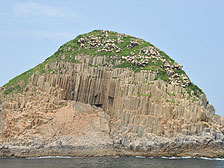
Rock of ages:
The remnants of an ancient supervolcano have been discovered in the southeastern part of Hong Kong.
Rock of ages:
The remnants of an ancient supervolcano have been discovered in the southeastern part of Hong Kong.
Ancient supervolcano discovered
August 30, 2012
An ancient supervolcano that last erupted 140 million years ago has been discovered in the southeastern part of Hong Kong.
Civil Engineering & Development Department Engineer Denise Tang told the media today the discovery is the by-product of meticulous geological surveying work.
The volume of erupted ash is estimated to have exceeded 1,300 cubic kilometres, she said, which can cover the whole of Hong Kong.
Known as the High Island Supervolcano, it is tilted on its side at about 30 degrees towards the east. The original diameter of the volcano's base was about 18km.
Ms Tang said the final pulse of volcanic activity about 140 million years ago was marked by the eruption of the High Island Supervolcano and straddles the boundary between the Jurassic and Cretaceous geological periods.
The cooled and solidified ash from the eruption forms the spectacular columns seen at High Island East Dam and across much of eastern Sai Kung. These columns are the centrepiece of the Hong Kong Global Geopark and attract thousands of visitors every year. Hexagonal rock columns can also be seen on the Ninepin Islands.
She said this is the first discovery of an ancient supervolcano in southeastern China, adding it may be one of many such volcanoes that were active between about 180 million and 80 million years ago along the southeastern China continental seaboard.
The supervolcano is thought to be the same type of modern-day collapse caldera that formed the Taal crater in the Philippines, and the Tambora and Krakatau volcanoes in Indonesia, but on a much larger scale, she said.